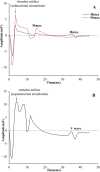Neuromuscular factors predicting lower limb explosive strength in male college sprinters
- PMID: 39839532
- PMCID: PMC11746912
- DOI: 10.3389/fphys.2024.1498811
Neuromuscular factors predicting lower limb explosive strength in male college sprinters
Abstract
Purpose: This study aimed to explore the effects of neural and muscular factors on lower limb explosive strength in male college sprinters, and build models based on those factors to identify the key neuromuscular factors that predict the rate of force development (RFD) and 30 m sprint time.
Method: 15 male college sprinters were recruited in this study, with 100 m personal best times under 10.93 s. The neuromuscular data were collected by H-reflex and V-wave, isokinetic muscle strength, vertical jumps, and 30 m sprint tests. Pearson correlation and multiple stepwise regression were used for data analysis. The level of statistical significance was set at p ≤ 0.05 for all analyses.
Results: 30 m sprint time had a significant moderate positive correlation with Achilles tendon stiffness (r = 0.50, p = 0.05, 95%CI: 0.01-0.81) and a significant moderate negative correlation with the H-index (r = -0.54, p = 0.04, 95%CI: 0.82 to -0.03), V wave (V/MmaxA, r = -0.59, p = 0.02, 95%CI: 0.85 to -0.11) and the eccentric strength of Hamstring (HECC, r = -0.53, p = 0.04, 95%CI: 0.82 to -0.03). The rate of force development (RFD) had a significant positive correlation with H reflex (Hmax/Mmax, r = 0.57, p = 0.03.95%CI:0.08-0.84), and the eccentric strength of Quadriceps (QECC, r = 0.53, p = 0.04, 95%CI: 0.02-0.82). V/MmaxA and HECC were identified as predictors of 30 m sprint time, and the R 2 explained 57.5% of the variance. Vertical stiffness and QECC explained 82.7% of the variation in the RFD.
Conclusion: This study found that V/MmaxA and HECC were predictive factors of 30 m sprint time, vertical stiffness and QECC were the predictive factors of RFD. Neural factors such as the α-motoneurons excitability of the spinal and supraspinal centers, have a greater influence on lower limb explosive strength in male college sprinters. Therefore, training related to the neural function of sprinters should be emphasized. In addition, H reflex and V wave can be used widely to assess and monitor the neural function of sprinters in future research. The impact of neural drive on muscles in different levels and sexes of sprinters, and the neuromuscular modulation during muscle contractions can be further explored.
Keywords: H-reflex; V-wave; neuromuscular; sprinter; stiffness.
Copyright © 2025 Li, Guo, Shao, Gan, Zhao and Zhou.
Conflict of interest statement
The authors declare that the research was conducted in the absence of any commercial or financial relationships that could be construed as a potential conflict of interest.
Figures
References
LinkOut - more resources
Full Text Sources



